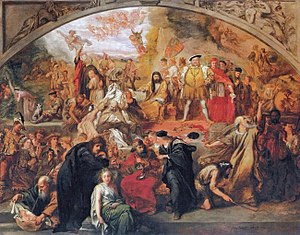
Back مسرحيات شكسبير Arabic উইলিয়াম শেকসপিয়রের নাট্যসাহিত্য Bengali/Bangla Shakespeares Werke German نمایشنامههای شکسپیر Persian Ուիլյամ Շեքսպիրի պիեսներ Armenian Las pèças de Shakespeare Occitan Peças de Shakespeare Portuguese Пьесы Уильяма Шекспира Russian П'єси Вільяма Шекспіра Ukrainian 莎士比亞嘅劇作 ZH-YUE

Shakespeare's plays are a canon of approximately 39 dramatic works written by the English poet, playwright, and actor William Shakespeare. The exact number of plays as well as their classifications as tragedy, history, comedy, or otherwise is a matter of scholarly debate. Shakespeare's plays are widely regarded as among the greatest in the English language and are continually performed around the world. The plays have been translated into every major living language.
Many of his plays appeared in print as a series of quartos, but approximately half of them remained unpublished until 1623, when the posthumous First Folio was published. The traditional division of his plays into tragedies, comedies, and histories follows the categories used in the First Folio. However, modern criticism has labelled some of these plays "problem plays" that elude easy categorisation, or perhaps purposely break generic conventions, and has introduced the term romances for what scholars believe to be his later comedies.
When Shakespeare first arrived in London in the late 1580s or early 1590s, dramatists writing for London's new commercial playhouses (such as The Curtain) were combining two strands of dramatic tradition into a new and distinctively Elizabethan synthesis. Previously, the most common forms of popular English theatre were the Tudor morality plays. These plays, generally celebrating piety, use personified moral attributes to urge or instruct the protagonist to choose the virtuous life over Evil. The characters and plot situations are largely symbolic rather than realistic. As a child, Shakespeare would likely have seen this type of play (along with, perhaps, mystery plays and miracle plays).[1]
The other strand of dramatic tradition was classical aesthetic theory. This theory was derived ultimately from Aristotle; in Renaissance England, however, the theory was better known through its Roman interpreters and practitioners. At the universities, plays were staged in a more academic form as Roman closet dramas. These plays, usually performed in Latin, adhered to classical ideas of unity and decorum, but they were also more static, valuing lengthy speeches over physical action. Shakespeare would have learned this theory at grammar school, where Plautus and especially Terence were key parts of the curriculum[2] and were taught in editions with lengthy theoretical introductions.[3]
- ^ Greenblatt 2005, p. 34.
- ^ Baldwin, T. W. (1944). Shakspere's Small Latine and Less Greek. Urbana: University of Illinois Press, 499–532).
- ^ Doran, Madeleine (1954). Endeavors of Art. Madison: University of Wisconsin Press. pp. 160–171.